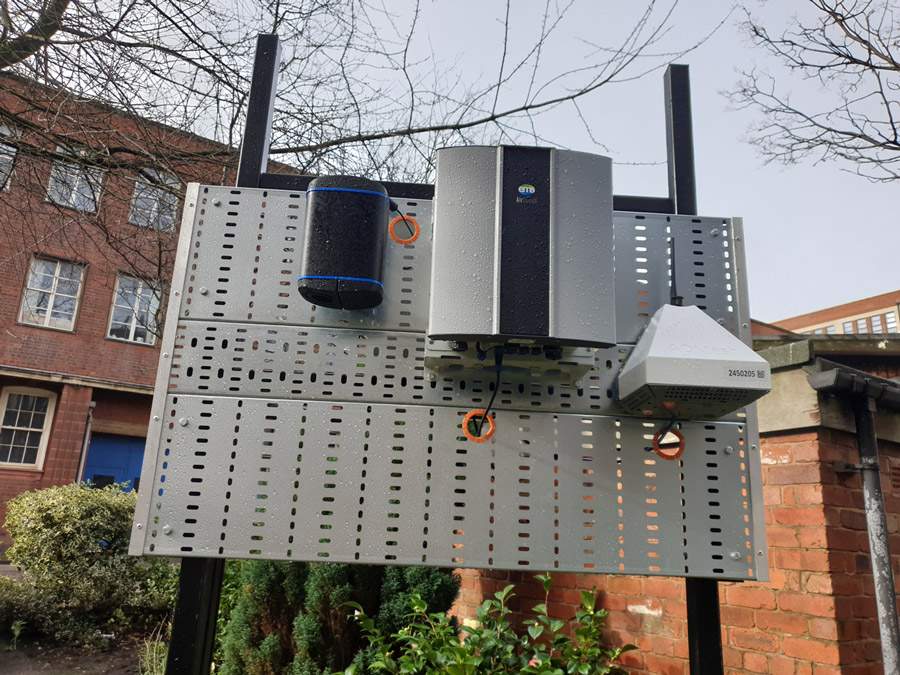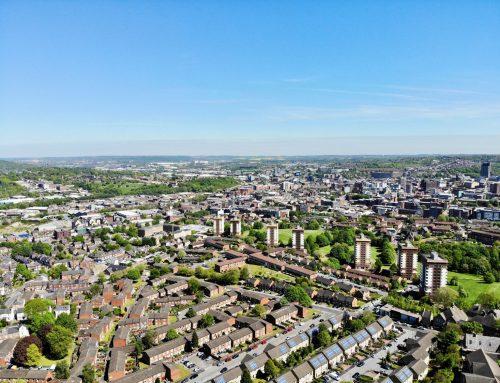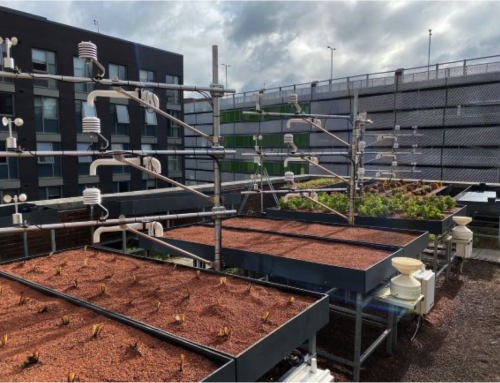The Air Quality Sensor Farm at the University of Sheffield (more sensors coming soon).
Air pollution in large cities has become one of the hottest topics in environmental issues. According to a recent report, it caused 6.4 million deaths worldwide in 2015. Furthermore, poor air quality causes premature mortality, hospital admissions, allergic reactions, lung cancer, cardiovascular diseases and both chronic and acute respiratory diseases, including asthma.
It is reported that air pollution has strong links with dementia, causing 850,000 people in the UK to suffer. Additionally, children growing up in homes near busy roads and junctions have a much higher risk of developing various respiratory diseases, including asthma, due to high levels of air pollution. Therefore, it is important to monitor air quality, especially on roadsides and in large cities like Sheffield, to report on hotspots of air pollution. Hotspots are those locations where air pollution levels are generally higher and likely to exceed air quality guidelines, so may cause negative impacts on human health.
This blog will mainly discuss four areas:
- the problem of air pollution;
- how air quality is monitored;
- air quality sensors; and
- Air Quality Sensor Farm (AQSF).
Air Pollution Monitoring
Air pollution monitoring is the process of measuring air pollution levels in the atmosphere using different air quality sensors. It is important to measure the levels of different air pollutants and report them to the decision making authorities and public. In the case of air pollution levels violating air quality guidelines, the decision can be made to cut emissions and manage air quality levels. Also, if air pollution levels are elevated, a warning can be issued to the public so they can take precautionary action. Air pollution monitoring also provides data for model validation, giving the ability to verify that the models are performing as expected.
Types of Air Quality Sensors
Air quality sensors are tools and devices which are used to measure the levels of air pollutants in the atmosphere. As air quality has emerged as a serious environmental threat to human health and wellbeing, new air quality sensors are being introduced into the market by different manufacturers, with updated technology.
There are four main types of air quality sensors: (a) Reference or conventional air quality monitoring sensors; (b) Portable or mobile air quality sensors; (c) Passive diffusion tubes for gaseous pollutants; and (d) Digital or low-cost sensors (LCS). We will be focusing on the last type in this blog i.e. LCS.
In contrast to reference sensors, the new digital sensors are smaller in size, compact, much cheaper, user-friendly and provide high resolution spatiotemporal air pollutant concentrations. They have the potential to enhance the existing air quality networks operated at local levels by local authorities and nationally by DEFRA in the UK. In addition, these sensors can be installed independently by various research and governmental organisations to monitor public exposure to various air pollutants within a specific area. Despite all these positive points, the quality of air pollution data collected by these LCS is unproven and cannot be used for regulatory and compliance purposes. However, the data can be used for highlighting air pollution hotpots, for public awareness and for complementing traditional air quality monitoring programmes.
The Urban Flows Observatory have built a dense-network of the LCS in Sheffield, mainly using Envirowatch E-motes and AQMesh pods (for more details on the air quality network and these sensors, please refer to the references at the end). When new air quality sensors are introduced into the market, although they have been tested in the laboratory by the manufacturers, they are rarely exposed to outdoor environmental conditions. Therefore, their performance is questionable. They need to be installed in the outdoor climatic conditions and their measurements compared to those from other sensors. This is where the Air Quality Sensor Farm (AQSF) comes into play.
What is an Air Quality Sensor Farm (AQSF)?
First things first, let’s define what is a farm, and what is a sensor or air quality sensor farm.
According to the Cambridge Dictionary, “a farm is an area of land, together with house and buildings, used for growing crops and/or keeping animals as a business”. Traditionally, the term farm was used in relation to agriculture and had different forms, such as arable farms, vegetable farms, fruit farms, dairy farms, pig farms and poultry farms. In modern times, the term has been extended to include such industrial operations as wind farms and fish farms, both of which can operate on land or sea. In a wider sense, a farm is an area containing a number of similar structures or objects, for example radio antennas, storage tanks or sensors. A sensor farm is a place or structure where a number of sensors are installed to collect data. In ours, the sensors will be used for air quality monitoring, therefore we call it an “Air Quality Sensor Farm”.
Why was the AQSF formed at the Urban Flows Observatory?
The main aim of the AQSF was to install several air quality sensors at the same location for a given period of time, so their performance could be compared with each other and ideally with a reference sensor. Sensors could be of any number and installed for any length of time. Ideally, the sensors should be installed for a whole year, so they are exposed to different climatic conditions such as temperature, relative humidity, wind and rain. This will help us determine how the performance of sensors is affected by the meteorological conditions and different levels of various pollutants. For example, this will determine how the sensor measurements are affected when the temperature drops below zero and the particulate matter level is higher than the air quality standard, and vice versa. Without such robust comparison in the outfield environment, it is difficult for a researcher to trust the measurements of a sensor.
How many and what types of sensors will be installed at the AQSF?
The minimum number of sensors should be two (2), however, there is no limit to the maximum number of sensors to be installed at the AQSF, generally the more the better.
The sensor farm structured by the Urban Flows Observatory is located at the University of Sheffield, within the Faculty of Engineering. To be specific, it’s in the courtyard between the Sir Frederick Mapping, Amy Johnson, Sir Robert Hadfield and Palm Liversidge Buildings (latitude 53°22’54.24″N and longitude 1°28’41.31″W).
At the start, five (5) air quality sensors will be installed side by side at the AQSF. The sensors installed are:
- AQMesh pod,
- Envirowatch E-mote,
- EarthSense Zephyr,
- Aeroqual AQY, and
- EMS AirSonde.
There is space for further installation, so the number of sensors might increase in the future.
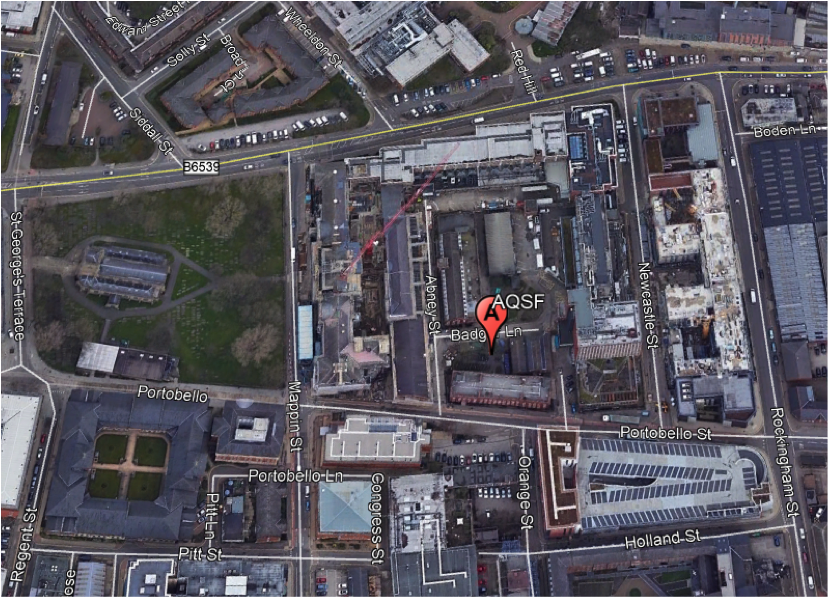

Figure 1. Location of the AQSF installed at the University of Sheffield
The sensors used in the ASQF
1. Envirowatch E-mote
The Envirowatch E-mote was launched in 2010. E-motes use the latest generation of electrochemical sensors made by Alphasense. E-motes measure the levels of three gaseous pollutants: carbon monoxide (CO), nitric oxide (NO) and nitrogen dioxide (NO2). In addition, it measures the levels of noise, relative humidity and temperature.
The E-motes use wireless technology to communicate their sensor reading and can be deployed on lamp posts or other street furniture (Figure 2). E-motes in a cluster communicate with a gateway by means of the Zigbee protocol within a specific area for high-resolution monitoring. The use of this protocol allows the individual units to communicate with each other and pass data from sensors that are not in range, or without line-of-sight of the gateway. Using GPRS, the gateway device communicates the collected data over an internet connection to a cloud server operated by Envirowatch. The data is post-processed and presented for access by users via the Enviroview web interface, as well made available for download via an application programming interface (API). More details are available on the Envirowatch website: http://www.envirowatch.ltd.uk/.
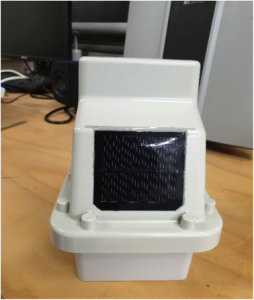
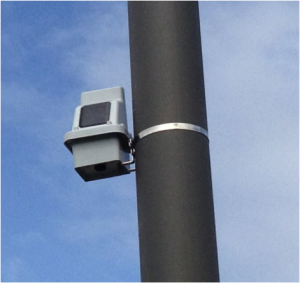
Figure 2. Envirowatch E-mote
2. AQMesh pod
AQMesh (Figure 3) are manufactured by Environmental Instruments Ltd. These are low-cost micro-scale sensors for effective environmental monitoring. They’re developed for harsh outfield environmental conditions and are capable of working to international standards. AQMesh microsensors measure the concentrations of NO, NO2, O3, SO2 and CO using the latest generation of electrochemical sensors. Using solid state sensors, they can also measure the levels of temperature, RH and atmospheric pressure. Particulate matter is measured using a light scattering optical particle counter. AQMesh nodes are affected by the levels of relative humidity due to increasing or decreasing volume of the aqueous electrolyte. These sensors are run by battery (up to 2 years of life) with different charging options including solar power. More details are available on the AQMesh website: https://www.aqmesh.com/.
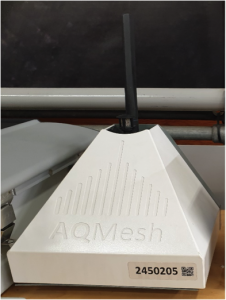
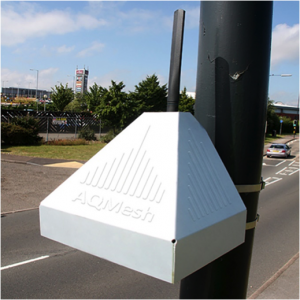
Figure 3. AQMesh pod
3. Aeroqual AQY
Aeroqual AQY is an LCS air quality sensor developed by Aeroqual Limited, supported by the government of New Zealand. It is a semi-professional product used by small and large networks. It’s designed to be used not only by air quality agencies, researchers, and air quality consultants, but also by schools, recreational facilities, and community groups.
Aeroqual AQY measures the following parameters:
- Particulate matter (PM2.5& PM10)
- Ozone (O3)
- Nitrogen Dioxide (NO2)
- Temperature and Relative Humidity
- Dew point
The Aeroqual AQY communicates wirelessly (WiFi), but 4G cellular and mesh options are also available. The AQY has on-board storage to ensure no data ever gets lost. In contrast to AQMesh and Envirowatch E-motes, which send the data to the cloud, data can be downloaded directly from the instrument itself. At present, power is mains-supplied only via a 12VDC outdoor-friendly plug pack. The unit weighs about 1 kg and can be mounted onto walls, poles or railings, using a supplied mounting bracket or simply with cable ties. It is primarily meant for fixed position air quality monitoring. More details are available on the Aeroqual website: https://www.aeroqual.com/aqy-smart-air-quality-monitor.
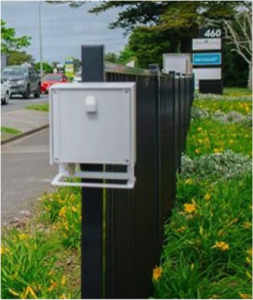
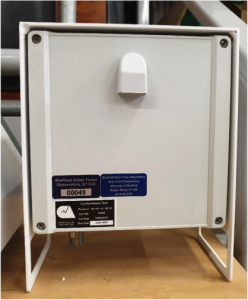
Figure 4. Aeroqual AQY
4. Earth Sense Zephyr
The Zephyr (Figure 5) is a compact and lightweight air quality sensor made by Earth Sense, UK. Earth Sense has 15 years of air quality expertise and was born out of the University of Leicester. Zephyr measures both gaseous and particulate pollutants. It is enabled with GPS and can be used as a static sensor installed at a fixed position, and as a mobile monitoring sensor carried by people while walking, cycling or driving. The in-built GPS provides accurate positional information for each measurement. It is powered by a solar panel or DC power supply. Zephyr measures gaseous pollutants, including NO, NO2, O3, SO2, H2S, CO and particulate matter (PM1, PM2.5, PM10).
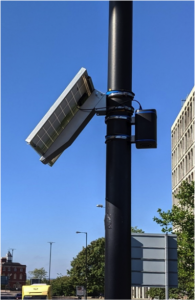
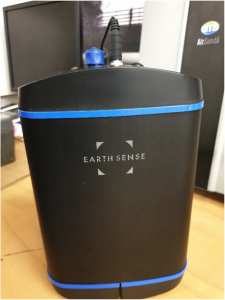
Figure 5. Earth Sense Zephyr
5. EMS AirSonde
AirSonde is manufactured by EMS (Environment Monitoring Solutions Ltd), which was established in Sheffield in 2002. The AirSonde is a state-of-the-art, compact air quality sensor. AirSonde monitors particulate matter (PM1, PM2.5, PM10), gaseous pollutants (CO, CO2, NO, NO2, SO2, O3), solar radiation (visible and UV), noise, and meteorological parameters (wind speed, wind direction, relative humidity and temperature). AirSonde has its own independent solar power source. It uses electrochemical sensing for gaseous air pollutant monitoring, except CO2, for which it uses nondispersive infrared detector (NDIR). Laser scattering technology is used for PM measurement and response time is 30 to 120 seconds. It can be mounted on a pole or wall like other LCS, however it is slightly heavier at 9.8 kg, than most of the LCS such as AQMesh and Envirowatch E-mote. More details are available on the AirSonde website: https://www.em-solutions.co.uk/airsonde/.
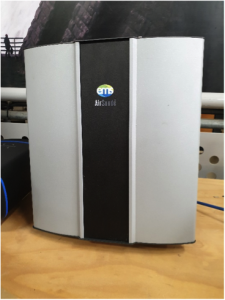
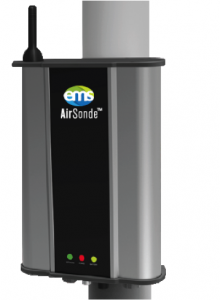
Figure 6. EMS AirSonde
Summary
Air pollution has emerged as a growing environmental concern for public health in large urban areas. Different types of air quality sensors are used to monitor the levels of air pollution and analyse their spatiotemporal variability. It is vital that the sensors used for air quality monitoring are validated and tested in the outdoor environment. In this blog various types of sensors used by Urban Flows Observatory are discussed briefly. An Air Quality Monitoring Network has been structured which is already measuring the levels of various air pollutants and meteorological parameters in the whole city of Sheffield – MOBIUS. Furthermore, an Air Quality Sensor Farm (AQSF) has been installed to compare the performance of different sensors with each and with reference sensors. At the moment five different types of sensors are installed at AQSF including AQMesh pod, Envirowatch E-mote, EarthSense Zephyr, Aeroqual AQY, and EMS AirSonde. The number and types of sensors might increase with time. This will increase researchers and public trust in the sensors and the data collected.
Author:
Dr. Said Munir, Urban Flows Observatory, University of Sheffield
References
- Munir, S., Mayfield, M., Coca, D., Jubb, S.A., 2019. Structuring an Integrated Air Quality Monitoring Network in Large Urban Areas – Discussing the Purpose, Criteria and Deployment Strategy. Atmospheric Environment: X 2 (2019): 100027.
- Munir, S., Mayfield, M., Coca, D., Jubb, S.A., Osammor, O., 2018. Analysing the performance of low-cost air quality sensors, their drivers, relative benefits and calibration in cities – a case study in Sheffield. Environmental Monitoring and Assessment, 191(2):94.

